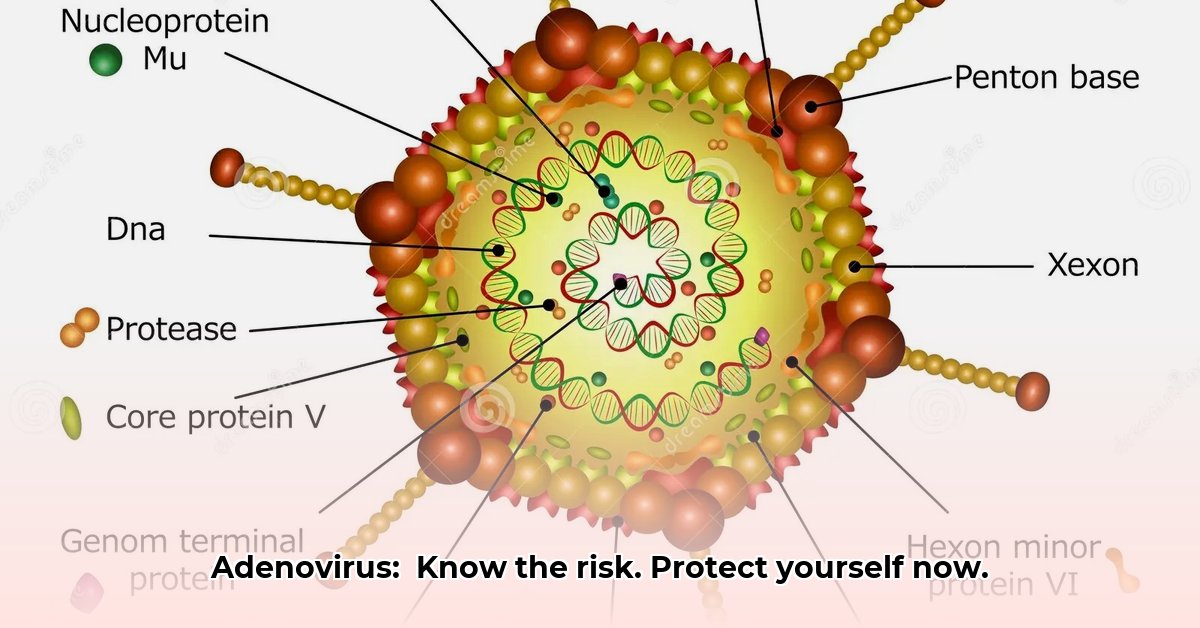
Adenovirus: Understanding the Tiny Troublemakers
Adenoviruses are common viruses causing a range of illnesses, from a mild cold (like that nagging cough) to more serious infections. While usually not a major cause for concern, understanding how they spread and what symptoms to watch out for can help you protect yourself and your family. Think of them as sneaky little viruses, constantly lurking, ready to cause a bit of a ruckus. But don't panic! Armed with knowledge, we can tackle them head-on. How many times have you experienced a seemingly unending cold? It could well have been an adenovirus.
Spreading the Word: How Adenoviruses Spread
Adenoviruses are clever little hitchhikers. They travel primarily through respiratory droplets – those tiny particles released when we cough or sneeze. Imagine a crowded room; one infected person can easily spread the virus to many others. Direct contact is another route; touching a contaminated surface (like a doorknob or shared toy) and then your face can transmit the virus. They're also surprisingly resilient, surviving for a period on surfaces. This emphasises the importance of regular cleaning. Does this sound familiar? It might explain why that dreaded cold lingers!
Adenovirus Symptoms: A Range of Possibilities
The symptoms of an adenovirus infection vary widely, from mild to moderately severe. A mild infection might feel like a common cold: runny nose, sore throat, and a cough. More significant infections can include fever, diarrhoea, and conjunctivitis (pink eye). Rarely, particularly in people with compromised immune systems, more serious complications such as pneumonia or bronchitis can develop. Have you noticed any of these lately? It raises the question: could it be an adenovirus?
High-Risk Groups: Who's More Vulnerable?
While most people recover from an adenovirus infection relatively easily, certain groups are at a higher risk of developing serious complications. Young children, whose immune systems are still developing, are more vulnerable. Similarly, those with weakened immune systems (due to illness or medication) are also at greater risk. Their bodies might struggle to fight off the infection effectively, potentially leading to a more severe illness. This highlights the need for extra care for these vulnerable populations. Isn't it vital to protect those most at risk?
Diagnosis and Treatment: What to Expect
Diagnosing an adenovirus infection often relies on a doctor evaluating your symptoms. While specific tests are usually not required unless serious complications develop, a doctor might use a few different tests, for example, analysing a sample of nasal secretions, stool or even a swab from your eyes. Typically, infections resolve on their own within a week or two with supportive care, focused on managing the symptoms. Rest, fluids, and over-the-counter medications for fever and pain relief are generally recommended. Remember, there’s no specific antiviral medication for adenoviruses, so it’s about supporting your body's natural healing process.
Preventing Adenovirus: Your Actionable Plan
While there's no vaccine currently available, prevention remains our strongest weapon. Let's focus on proactive measures to minimise your risk:
- Handwashing: Wash your hands frequently with soap and water for at least 20 seconds, particularly after being in public places or before meals. This simple act significantly reduces the spread of many infections, including adenoviruses.
- Surface Disinfection: Regularly clean and disinfect frequently touched surfaces (phones, doorknobs, etc.) with a suitable disinfectant. This can dramatically reduce the transmission of adenoviruses.
- Respiratory Etiquette: Cover your coughs and sneezes with your elbow (not your hands) to help prevent the spread of respiratory droplets.
- Social Distancing (When Appropriate): If someone you know is sick, maintaining a safe distance can reduce your exposure.
Following these steps can significantly lessen your chances of contracting an adenovirus infection. This is not a complicated strategy, it's about mindful habits for your health. Simple, yet effective, don't you think?
Conclusion: Empowering Yourself Against Adenoviruses
Adenoviruses are commonplace, causing a spectrum of illnesses. While most infections are mild, understanding their transmission, symptoms, and preventive measures empowers you to protect yourself and loved ones. Remember, consistent handwashing, surface disinfection, and good respiratory etiquette are crucial. While there is no specific antiviral cure, prevention is your primary defense. By following these simple steps, you can reduce your risk and maintain your overall well-being. This information is your powerful tool against these sneaky viruses.
Key Takeaways:
- Adenoviruses are widespread and cause various illnesses.
- Transmission occurs through respiratory droplets, direct contact, and contaminated surfaces.
- Young children and immunocompromised individuals are more vulnerable.
- Prevention through good hygiene is your best defence.